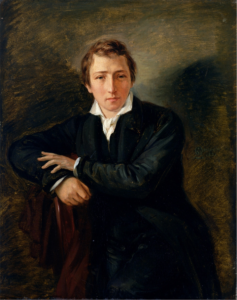A picture of her
(Poet's title: Ihr Bild)
Set by Schubert:
D 957/9
[August 1828]
Part of 13 Lieder nach Gedichten von Rellstab und Heine (“Schwanengesang”), D 957
Ich stand in dunkeln Träumen
Und starrt’ ihr Bildnis an,
Und das geliebte Antlitz
Heimlich zu leben begann.
Um ihre Lippen zog sich
Ein Lächeln, wunderbar,
Und wie von Wehmutstränen
Erglänzte ihr Augenpaar.
Auch meine Thränen flossen
Mir von den Wangen herab –
Und ach, ich kann es nicht glauben,
Dass ich dich verloren hab.
In dark dreams I was standing
And I was staring at a picture of her,
And the beloved face
Secretly started to come to life.
Around her lips there appeared
An amazing smile,
And as if lit up by tears of melancholy
Her two eyes were shining.
My tears too flowed
And fell from my cheeks –
And, alas, I cannot believe
That I have lost you!
All translations into English that appear on this website, unless otherwise stated, are by Malcolm Wren. You are free to use them on condition that you acknowledge Malcolm Wren as the translator and schubertsong.uk as the source. Unless otherwise stated, the comments and essays that appear after the texts and translations are by Malcolm Wren and are © Copyright.
☙
Themes and images in this text:
Cheeks Dreams Eyes Faces Lips Lost and found Melancholy Pictures and paintings Smiling Tears and crying
Modern neuropsychology has confirmed what Heine and many poets before him understood intuitively: there is a difference between how human beings look at faces and other things. Different regions of the brain are activated when looking at a tree (or a painting of a tree) from when we see a face (or a portrait). For all but a very small number of people the neural processes involved in dealing with faces involve as much emotional response as visual cognition. This must be why the poet feels that the picture he was looking at came alive ‘secretly’. Other people would not have observed the same animation in her features because the visual stimuli were not wired in to the same emotional associations.
It is actually impossible for us to look at a familiar face (or an image of a familiar face) without responding on a subjective level. There can be no clear separation between the detached object and the subjective viewer in these cases. As this speaker spends more time staring at the portrait, the smile that flickers on the lips of the beloved appears on the face of the viewer too. It is the same smile, in fact. Similarly with the tears. As the distressed observer starts to cry, the eyes in the portrait begin to glisten (even though it appears to him to be the other way round).
Now all pretence at objectivity has broken down. It is no longer a portrait of ‘her’ that ‘he’ is looking at. The whole history of the relationship floods into his consciousness. ‘I’ have lost ‘you’, he declares, though he still cannot believe it. Although we the readers (or the eavesdroppers) would like to know more about the nature of this loss (did she reject him? did others intervene to break them apart? has she died? was she just a fantasy that he is trying to grow out of?), we do not need to be told. The text is not really for us and it is definitely not intended to satisfy our curiosity. Its purpose is to allow the speaker to deal with the cognitive and emotional challenge of looking at a picture of her – Ihr Bild.
☙
Original Spelling Ihr Bild Ich stand in dunkeln Träumen Und starrt ihr Bildniß an, Und das geliebte Antlitz Heimlich zu leben begann. Um ihre Lippen zog sich Ein Lächeln wunderbar, Und wie von Wehmuthsthränen Erglänzte ihr Augenpaar. Auch meine Thränen flossen Mir von den Wangen herab - Und ach, ich kann es nicht glauben, Daß ich Dich verloren hab'!
Confirmed by Peter Rastl with Schubert’s source, Buch der Lieder von H. Heine. Hamburg bei Hoffmann und Campe. 1827, page 201; and with Reisebilder von H. Heine. Erster Theil. Hamburg, bey Hoffmann und Campe. 1826, page 27.
To see an early version of the text, go to page 201 [207 von 384] here: http://digital.onb.ac.at/OnbViewer/viewer.faces?doc=ABO_%2BZ180399009


